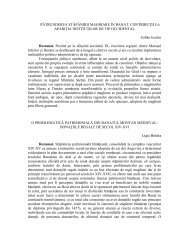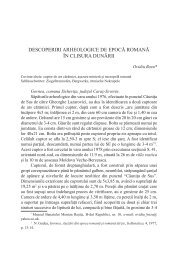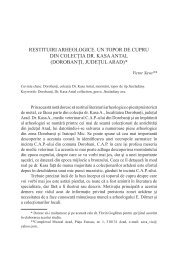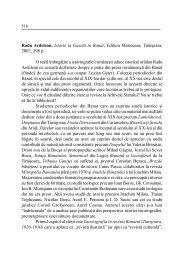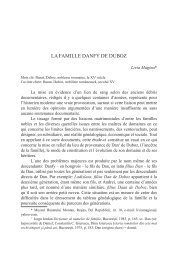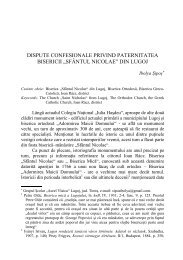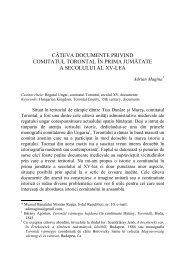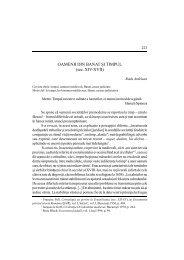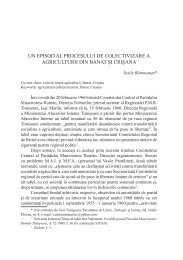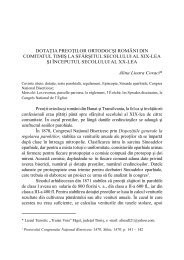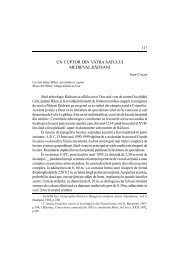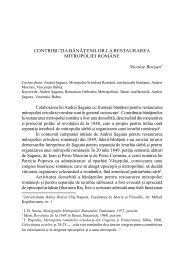Alexandru Simon - Banatica
Alexandru Simon - Banatica
Alexandru Simon - Banatica
Create successful ePaper yourself
Turn your PDF publications into a flip-book with our unique Google optimized e-Paper software.
in view of his Polish marriage. The pope backed him up compelling Krakow to<br />
issue a formal approval of the marriage (1506-1507), disliked in essence by<br />
both Istanbul (fearful of any Moldavian increase in power) and Vienna (who<br />
felt that she was losing her Moldavian ally in the competion with the House of<br />
Jagiello). Still, though Julius II repeatedly intervened in his favor (the pope had<br />
his own design for the region which did not ‘fully’ coincide with that of<br />
Maximilian), Bogdan III was not allowed to marry Elisabeth. The main official<br />
Polish reason for refusal was that Bogdan III was still a schismatic. Krakow<br />
was in fact much more worried about Bogdan’s potential influence over her<br />
affairs in all Jagiellonian kingdoms after his marriage. A union, in the fashion of<br />
the Polish-Lithuanian union, between Krakow and Suceava was eventually<br />
turned down by all sides. By 1509, Moldavia and Poland were back at war. In<br />
July, Moldavians and Turks defeated the Poles. Bayezid II did not want to<br />
break his treaty with king Sigismund of Poland, but he feared even more an<br />
entente between the Polish and Moldavian rivals at the northern border of the<br />
empire 4 .<br />
In February 1510, peace was concluded between Sigismund and Bogdan.<br />
Buda and Rome had made great efforts to see the conflict ended. The settlement<br />
4 E.g. MOL, (Q section) Diplomatikai Levéltár [Diplomatic Archive] (DL), [no.] 21783 (21 st of<br />
November 1507; edited under September 25, 1508, in Actae et epistolae, no. 71, p. 94); Hurmuzaki,<br />
II-2, 1451-1510, editor Nicolae Densusişanu, Bucharest, 1891, nos. 432-433, p. 534-541; no.<br />
448 p. 557; no. 459, p. 578; nos. 465-467, p. 583-586; Actae et epistolae, nos. 63-64, p. 75-81;<br />
Materialy, no. 43, p. 128; nos. 46-47, p. 148-150, nos. 49-51, p. 153-163; no. 54, p. 166-168;<br />
Sanudo, IX, 1 Agosto 1509-28 Febbraio 1510, Venice, 1883, cols. 99-100. The reference works<br />
on Moldavia after 1504 (and in particular up to 1527, up to the enthronement of Peter IV Rareş,<br />
Stephen III’s best known illegitimate son) are rather sparse and often lack the historical overview<br />
(in particular in relation to Bogdan III, also known as Bogdan the Blind or the One Eyed,<br />
because of his glaucoma), as well the needed informational basis (e.g. D. Ciurea, Relaţiile<br />
externe ale Moldovei în secolul al XVI-lea, in AIIA Iaşi, X, 1973, p. 1-47, in particular, in this<br />
context, p. 2-6, and Horia I. Ursu, Moldova în contextul politic european. 1517-1527, Bucharest,<br />
1972, notably p. 66-72. Two notable exceptions have to be emphasized however: first, the nowadays<br />
outdated seminar work of Iulian Marinescu, Bogdan III cel Orb, domn al Moldovei (1504-<br />
1517), Bucharest, 1910, p. 17-31, in this case, but mainly Virgil Pâslariuc’s synthesis Raporturile<br />
politice dintre marea boierime şi domnie în Ţara Moldovei în secolul al XVI-lea, Kishinev,<br />
2005, here p. 24-31. Plus, in several respects, the (overlooked on eastern soil) PhD thesis of<br />
Marianna Mur, Die Ostpolitik Kaiser Maximilians I. in den Jahren 1506-1519, Graz, 1977,<br />
here p. 111, 131-132, can be viewed as a more important scientific addition than most studies<br />
referring to the reign of Bogdan III.<br />
59



